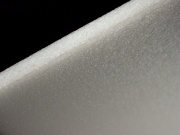Difference between revisions of "Closed cell foam"
Jump to navigation
Jump to search
m (Text replace - "== Authority ==" to "== Sources Checked for Data in Record ==") |
|||
| (One intermediate revision by the same user not shown) | |||
| Line 1: | Line 1: | ||
[[File:closedcellpolyfoam.jpg|thumb|Closed cell polyethylene foam]] | [[File:closedcellpolyfoam.jpg|thumb|Closed cell polyethylene foam]] | ||
== Description == | == Description == | ||
| + | [[File:closedcellpolyfoam2.jpg|thumb|Closed cell polyethylene foam]] | ||
| + | A dense, durable [[Foams (table)|foam]]. Closed cell foams have unconnected air cells that are formed by incorporating gas bubbles into the structure of the foam. This can be done mechanically by mixing in the bubbles or a low-boiling [[solvent]] into the [[polymer]] prior to curing, or chemically by adding a blowing agent that evolves [[gas]]. | ||
| − | + | ==Applications== | |
| + | * Furniture | ||
| + | * Carpet underlay | ||
| + | * Bedding | ||
| + | * Insulation | ||
| − | == | + | ==Physical and Chemical Properties== |
| − | + | * Hydrophobic | |
| − | + | * Good insulator | |
| − | + | * Density = 1.5-2.5 g/ml | |
| − | |||
| − | |||
| − | |||
| − | |||
| + | ==Resources and Citations== | ||
| + | * Foam How: [https://foamhow.com/foam-quick-reference-guide.pdf Quick Reference Guide] | ||
* Pam Hatchfield, ''Pollutants in the Museum Environment'', Archetype Press, London, 2002 | * Pam Hatchfield, ''Pollutants in the Museum Environment'', Archetype Press, London, 2002 | ||
Latest revision as of 14:09, 6 February 2024
Description
A dense, durable foam. Closed cell foams have unconnected air cells that are formed by incorporating gas bubbles into the structure of the foam. This can be done mechanically by mixing in the bubbles or a low-boiling Solvent into the Polymer prior to curing, or chemically by adding a blowing agent that evolves Gas.
Applications
- Furniture
- Carpet underlay
- Bedding
- Insulation
Physical and Chemical Properties
- Hydrophobic
- Good insulator
- Density = 1.5-2.5 g/ml
Resources and Citations
- Foam How: Quick Reference Guide
- Pam Hatchfield, Pollutants in the Museum Environment, Archetype Press, London, 2002

